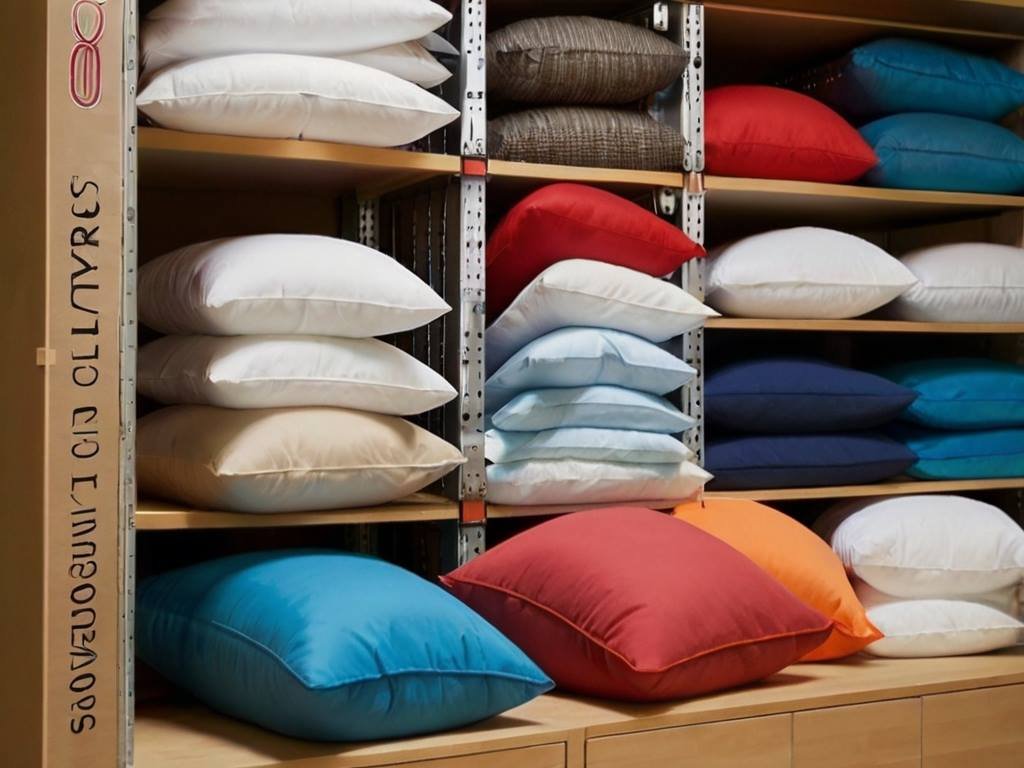Properly keeping pillows is sometimes ignored, yet it is critical to ensure their form, cleanliness, and overall quality.
Whether you’re moving, dealing with seasonal bedding changes, or just need more storage space, understanding how to store pillows in a storage unit is vital.
In this detailed guide, we’ll walk you through each step of keeping your pillows in top shape.
Selecting Right Storage Containers
Wondering if can pillows be stored in vacuum storage bags? When it comes to storing pillows in a storage unit, the significance of choosing appropriate containers cannot be stressed.
The type of container you use has considerable influence on the condition of your pillows while in storage. Here’s a full summary of concerns and actions to take:
Clean and Dry Containers
Before utilizing any containers, make sure they are clean and dry. Cleaning containers helps to remove dust, filth, and other pathogens.
Dampness in containers can cause mold and mildew, so ensure they are completely dry before storing pillows inside.
Adequate Ventilation
Choose containers with full airflow to prevent moisture accumulation. Pillows must breathe even when stored, and good ventilation decreases the danger of mildew and unpleasant odors. Containers made from permeable materials or with ventilation holes are ideal solutions.
Consider Container Size
Choose containers that fit the size of your pillows. Oversized containers might cause pillows to move during shipping and storage, potentially leading to deformities.
On the other hand, too-small containers may compress the pillows, reducing their fluffiness and form.
Container Store Options
The container store pillow storage is a dependable supplier for a wide range of storage solutions.
Explore their selection of pillow storage containers intended to satisfy a variety of purposes.
It offers a wide range of containers to meet different needs, from clear plastic containers for easy sight to fabric-covered containers for added protection.
Pillow Preparation
Find out the way from tips on how to store pillows in storage to maximizing space and maintaining their perfect condition.
Preparing your pillows for storage is an important step in keeping them in good condition. This procedure includes proper washing, removing pillows, and resolving any stains or smells.
Thorough Cleaning
Before storing your pillows, be sure to properly clean them. Follow the care recommendations included on the pillow’s labeling or box.
Most pillows, particularly those filled with synthetic materials, are machine washable. To clean them, use light detergent and run a soft cycle.
Consider having your down or feather-filled pillows professionally cleaned to preserve their loft and fluffiness.
Drying Pillows
Once washed, make sure the pillows are dry before storing. Dampness can produce mold and foul smells.
Use a dryer’s low-heat setting or let them air-dry completely. Fluff the pillows as they are trying to keep them in shape and prevent stuffing ingredients from clumping together.
Remove Pillowcases
Before storing your pillows, separate pillowcases or shams. Pillowcases should be washed and stored separately to ensure cleanliness.
Removing them also improves air circulation around pillows during storage, lowering the possibility of musty smells.
Addressing Stains and Odors
Make an effort to remove any stains or smells from your pillows before storing them. Stains can form over time, and smells may intensify during storage.
Spot-clean stains with a gentle detergent or use specialist stain removers that are appropriate for pillow material.
If the scents continue, try adding baking soda to pillows before storing them; just be sure to shake or vacuum them out before use.
By carefully prepping your pillows for storage, you not only keep them clean but also increase their durability and comfort when you recover them.
Vacuum Storage Bags
This section not only addresses how to store queen-size bedding and pillows for storage but also ensures they remain in the best possible condition until you need them again.
Vacuum storage bags can make storing pillows more efficient, especially if space is limited in your storage facility.
Understanding the benefits, and concerns, and answering frequently asked issues of whether pillows may be stored in vacuum storage bags are all important components of this storage strategy.
Space Maximization
Among the benefits of vacuum storage bags is that they take up significantly less space. These airtight bags compress pillows, eliminating extra air and reducing bulk.
This is especially useful when dealing with limited storage space since it allows you to keep more pillows in smaller areas.
Protection against Dust and Pests
Vacuum-sealed pillows offer an extra degree of protection against dust, mildew, and vermin.
The airtight closure keeps external factors out of pillows, ensuring they stay clean and in good condition throughout storage.
Suitable for Clean and Dry Pillows
It’s important to note that vacuum storage bags function best with clean, dry cushions. Any remaining moisture might cause mold development within the sealed bag.
Therefore, before utilizing vacuum storage bags, check that your pillows have been properly cleaned and dried.
Can Pillows Be Stored in Vacuum Storage Bags?
Yes, pillows can be stored in vacuum storage bags, but with few warnings. Pillows should be kept clean and dry to avoid mold and smell.
Furthermore, avoid compressing pillows with too much force, since this may damage their form and fluffiness.
When you’re ready to use pillows again, take them out of the vacuum-sealed bag, fluff them up, and let them return to their natural shape.
Labeling for identification
Despite the compressibility of vacuum storage bags, labeling is still required. Clearly label the bags with the type of pillow inside and any other relevant information.
This allows you to simply identify and retrieve certain pillows without having to open each bag.
Sorting Pillows in the Storage Unit
Effectively storing your pillows within a storage container not only maximizes space but also makes them easier to retrieve when required.
Consider the unit’s size, container kinds, and labeling system to create an ordered and accessible storage area.
Arrange for Maximum Space Utilization
Consider the storage unit’s size while organizing cushions. Stack containers wisely to maximize available space.
Larger and heavier goods should be placed at the bottom, with lighter ones, such as cushions, on top. This avoids unwanted moving during storage.
Container Selection and Placement
Use storage containers specified in the above section wisely. Stackable containers can be useful for maximizing vertical space.
To protect the pillows from dust and other pests, make sure to shut each container tightly.
Labeling for Easy Retrieval
Revisit the previously developed labeling system and confirm that it is regularly enforced. Clearly label each container with its contents and any other pertinent information.
This step is especially important if you have many sets of pillows of different varieties kept together. Labeling improves efficiency during storage and retrieval.
Accessibility
Consider how accessible your pillows are within the storage container. If you anticipate using various pillows at different times, make sure they are put in a way that allows for simple retrieval without upsetting the overall storage arrangement. Accessibility is essential for a hassle-free storage experience.
Protective Measures
When stacking containers, consider adding a protective layer, such as breathable cloth or cardboard, between each one.
This minimizes potential friction and damage between containers. Keeping pillows away from direct touch with the floor will also guard against wetness.
Environmental Considerations
Creating an ideal climate within a storage container is vital to protecting the quality of your pillows.
Temperature, humidity, and sunlight exposure may all influence how well-kept pillows hold up. Here’s a thorough look at the environmental aspects of pillow storage:
Climate-Controlled Storage Units
Whenever possible, use a climate-controlled storage unit. These units manage temperature and humidity, resulting in a steady atmosphere that reduces the likelihood of mold, mildew, and other environmental harm.
While these devices are significantly more expensive, additional security investments are justified.
Temperature and humidity control
Even in non-climate-controlled rooms, place pillows in locations with consistent temperatures and low humidity.
Extreme temperature changes and high humidity levels can cause condensation, which provides a breeding environment for mold. Keep pillows away from moisture-prone places like windows and vents.
Protection against Sunlight
Direct sunlight can cause fabric yellowing and damage over time. Keep your stored pillows away from windows and other sources of direct sunlight in a storage facility.
If transparency is important in container choices, consider utilizing opaque containers to protect pillows from damaging UV radiation.
Periodic Checkups
Periodic checks are essential for keeping your pillows in top shape during their storage duration.
Regular inspections allow you to quickly detect and fix any possible concerns, ensuring that your pillows are ready to use when needed.
Scheduled Inspections
Make a routine for regular checks of your stored pillows. Checks should be performed every few months, depending on storage time and ambient circumstances.
Consistent inspections help you to identify problems early and take remedial action before they worsen.
Visual inspection
During each checkup, carefully inspect each cushion for any signs of damage. Look for rips, stains, and other noticeable flaws.
If you notice any concerns, address them right away to avoid further deterioration. Consider using a flashlight to do a thorough investigation, particularly in corners or inaccessible spots.
Pest Control Measures:
Look for evidence of pests, such as rats or insects. Look for droppings, bite marks, or nest-related evidence.
If pests are identified, take prompt action to destroy them. Consider utilizing bug deterrents like mothballs or cedar sachets that are carefully put throughout the storage facility.
Repositioning and Fluffing
Over time, pillows may settle or lose their fluffiness. During checks, consider adjusting cushions within containers to distribute weight evenly.
Fluff pillows by gently shaking or kneading them to keep their form and loft.
By including frequent examinations in your pillow storage practice, you actively contribute to the durability and quality of your stored pillows.
Conclusion
To summarize, mastering the art of how to store pillows in a storage unit requires a series of deliberate and proactive procedures.
From selecting appropriate storage containers and properly prepping pillows to using vacuum storage bags and successfully arranging storage units, each step is critical to maintaining the quality of your pillows.
Environmental issues, like as choosing climate-controlled storage containers, shielding pillows from sunlight, and ensuring adequate ventilation, help to overall effectiveness of your storage plan.
Periodic checkups act as a preventive strategy, enabling you to solve any concerns before they risk the quality of your pillows.
When it comes to establishing safe reservations for your valuables, Freedomz Storage is the clear choice for guidance.
Our extensive blog on such topics nicely coincides with our mission to give broad insights into the best storage options.

